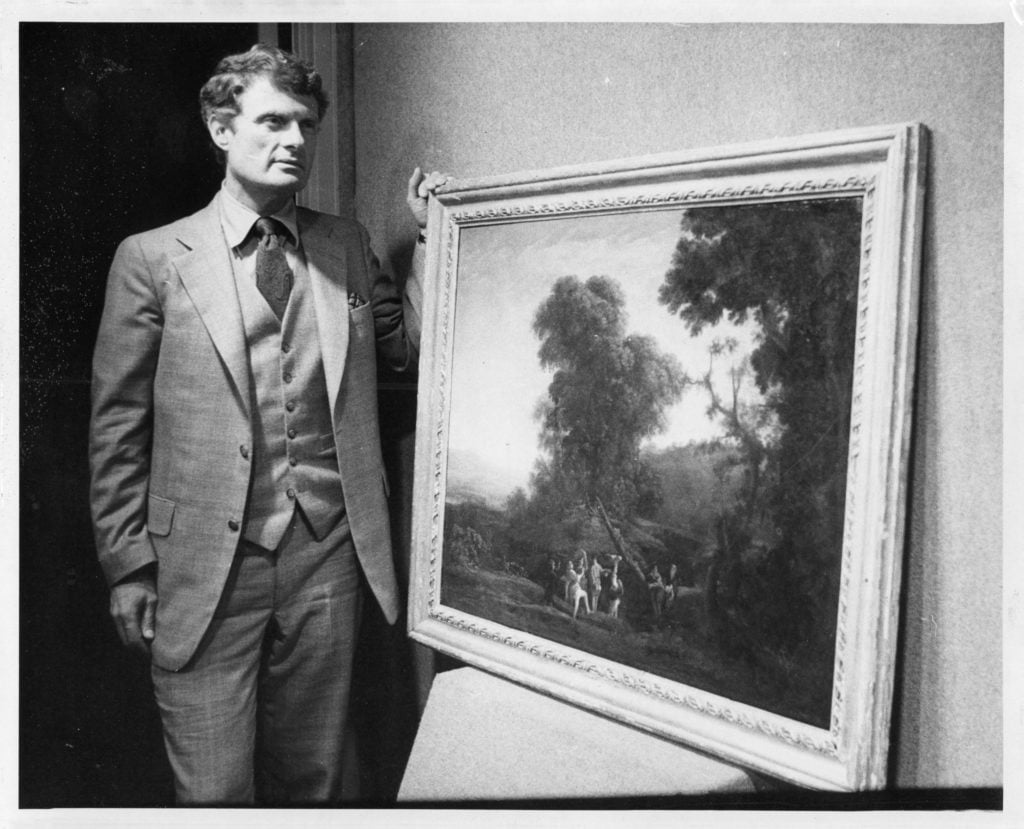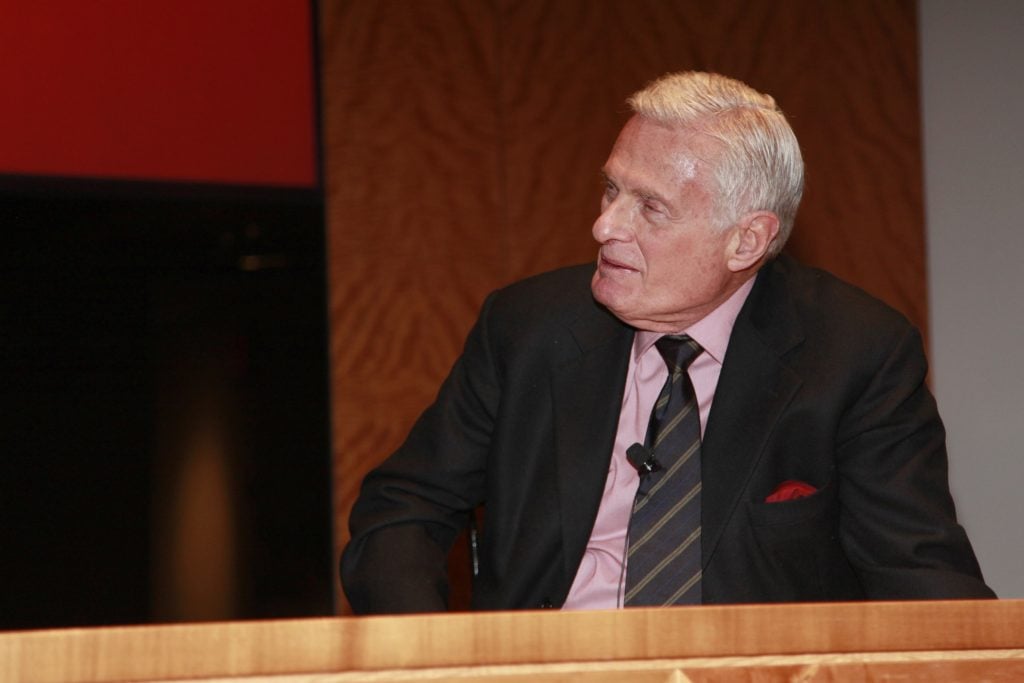People
Art Luminaries Pay Tribute to Richard Feigen, the ‘Collector in Dealer’s Clothes’ Revered for Championing Old and New Masters Alike
The late dealer placed masterpieces in more than 100 museums around the world

The late dealer placed masterpieces in more than 100 museums around the world

Eileen Kinsella

Art dealer Richard Feigen, a connoisseur of Old Master art, died on Friday morning in Mount Kisco, New York, due to complications from COVID-19. He was 90 years old.
Feigen, who ran galleries in Chicago, New York, and Los Angeles, supplied numerous important artworks to more than 100 museums around the world, including the Louvre, the Metropolitan Museum of Art, the National galleries of Washington and London, the Getty, and many others.
“Richard was an art dealer and collector who had a specific criteria he always considered, whether he was buying for trade or home, and that was the singular quality of innovation: the painting or drawing had to advance over all others of its time,” fellow Old Master dealer Otto Naumann told Artnet News. “His favorite phrase was ‘Don’t look in the rearview mirror.'”
Feigen opened his first gallery in Chicago in 1957, where he focused on German Expressionism and Surrealism. He championed artists including Francis Bacon, Jean Dubuffet, Joseph Cornell, Claes Oldenburg, Ray Johnson, and James Rosenquist. In 1963, he opened a second gallery in New York, where he showed work by Vincent van Gogh, Claude Monet, Pablo Picasso, Constantin Brancusi, and Piet Mondrian.
Just two years later, he became one of the earliest dealers to run a gallery in Soho, where he showed work by Joseph Beuys—the artist’s first significant exposure in the US—and John Baldessari, who Feigen gave his first New York show. (Feigen also figures prominently as a tuxedo-clad party-hopper in Tom Wolfe’s legendary 1970 essay “Radical Chic.”)
Met director Max Hollein noted Feigen’s eclectic tastes in a tribute to the late dealer on his Instagram: “Richard Feigen was an extraordinary man, great connoisseur of art from the Italian trecento through all centuries up to contemporaries like Peter Saul, Jim Rosenquist, or Ray Johnson (surprising for many who know him as one of the most important Old Master dealers).”

Richard Feigen at Sotheby’s on January 21, 2010 in New York City. Photo by Carrie Shaltz/Patrick McMullan via Getty Images.
Feigen invited Austrian architect Hans Hollein (father of Max Hollein) to design his headquarters on 79th Street in 1970, then inaugurated the space with an historic Monet exhibition that garnered national television coverage.
The dealer went on to spearhead the formation of Castelli, Feigen, Corcoran Gallery in New York, which represented the Joseph Cornell estate from 1976 to 1987. And in London, his Richard L. Feigen & Co. presented Old Masters from 1988 to 1995.
“Collectors and museums all over the world have benefited from his vision and he was generous with the institutions that he loved,” read a message on the Feigen gallery website.
In 2019 Feigen donated Carlo Saraceni’s altarpiece The Dormition of the Virgin to the Met in honor of the museum’s 150th anniversary.
“I was so glad that Richard Feigen was able to visit the newly renovated European paintings galleries and admire his gift,” the museum’s chief curator, Keith Christiansen, told Artnet News in an email. The altarpiece was Saraceni’s first replacement for a rejected picture by Caravaggio, Christiansen said, noting, “It’s not only a key work of Caravaggism, but part of one of the most intriguing and complex stories of acceptance and rejection in art history. This, too, is a perfect legacy for Richard, who seemed always battling against conventions. He had one of the most eventful careers of anyone involved in the arts and will be dearly missed.”
Feigen’s visit to the museum six weeks ago with his wife, Isabelle, to see the Saraceni installed “sadly turned out to be the last time we saw each other,” Hollein wrote. “Thank you Richard! I will miss you dearly!”
Whether Feigen had a succession plan for his galleries remains unclear. The gallery’s longtime president, Frances Beatty, left in 2017 to start a business with her son, Alex Adler.
“We had a great time, sold work to over 125 museums worldwide, and held more than 100 museum-quality exhibitions,” Beatty told Artnet News. “His commitment to Ray Johnson, who returned to us in 1995 after his death, in the form of his estate, which I now represent, was unshakable. He never wavered in his conviction that Johnson was a great artist despite his exasperating personality.”
Feigen could always be counted on for a colorful, incisive comment about the latest goings-on in the art market. In 2009, amid the global economic crisis, he sold a rare J.M.W. Turner painting at Sotheby’s New York, The Temple of Jupiter Panellenius Restored, which he had acquired 27 years earlier.
The painting sold for $12.9 million, on the lower end of its $12 million to $16 million estimate, but still a healthy result given the economic backdrop. When I asked him about it after the sale, he said, “I was satisfied with the price, which fell more or less within the estimate. In general terms, the buyer was wise and I was stupid. The painting will become much more valuable. There are only 20 or so Turners in private hands.”
Feigen sold works at Christie’s in May 2019 in order to raise money for his retirement. “I am a collector in dealer’s clothes,” he wrote in his 2000 book Tales from the Art Crypt.
News of the Christie’s sale came after Feigen had scaled back his operations in 2017, moving from a townhouse on East 69th Street (a building which Adler and David Zwirner now share) to a more modest space on 77th Street.
On the night before the sale, he joked with Christie’s Old Masters director François de Poortere, saying, “I hope none of them will sell because I want them back in my living room.”
But that was not the case. The sale set records for Annibale Carracci’s The Madonna and Child with Saint Lucy and the Young Saint John the Baptist, which sold for $6 million, and Lorenzo Monaco’s The Prophet Isaiah, which sold for $3.6 million.
De Poortere called Feigen “a true visionary in the global art world who made countless and startling discoveries throughout his career. He was known for his discerning eye and extraordinary taste and continued to champion the field of Old Masters. He will be greatly missed.”